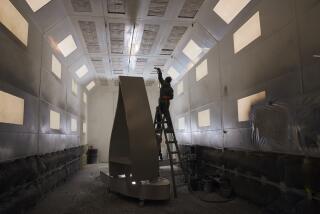The Greening of Work
When Toyota Motor Corp. moved one of its divisions into an environmentally friendly, or “green,” building in Torrance three years ago, it expected to save on its energy bills. The building offered natural lighting, electricity-generating rooftop solar panels and water recycling.
But something else also happened. Employee morale jumped while absenteeism fell. The overall energy and worker productivity savings more than offset the added cost of making the facility environmentally friendly.
“The lighting is easier on the eyes and on the nerves,” Toyota employee Mary Jo Moutsios said. “I take a sense of pride in working in this building. It’s pleasant and feels more productive.”
Results like Toyota’s are helping to spark a budding “green revolution” in American workplaces. The movement is starting to change how office buildings are designed and could render thousands of existing offices obsolete.
Employers including Goldman, Sachs & Co., Wal-Mart Stores Inc. and Harley-Davidson Inc. are starting to ask for buildings with more natural light, fresher air and fewer toxic materials in the paint, carpeting and other finishes.
Los Angeles, Salt Lake City and Chicago are among many cities requiring new public buildings to be green. Municipalities are offering incentives, such as faster construction approvals and reduced permit fees, to get the private sector to follow suit.
“This will be as big as the shake-ups that came after the invention of elevators and, later, central air conditioning,” Los Angeles real estate consultant Charles Lockwood said of the green movement in office design.
“You’ve got to get on board or risk being a dinosaur,” said Doug Holte, who heads West Coast operations for Hines, a Houston-based developer that is building green office towers in Irvine, La Jolla and Bellevue, Wash.
Although the green movement is in its infancy, its endorsement by a growing number of prestigious employers, developers and cities is seen as giving a shot in the arm to the nation’s environmental movement as concern about the effects of global warming and environmental pollution spread.
More than $7.7 billion of office buildings nationwide are up for official green certification, versus about $790 million in 2000. Among the more notable new green towers is 7 World Trade Center in New York, a 52-story skyscraper that replaced a building at the same address that was destroyed in the 2001 terrorist attacks.
“Some people think of this as a California thing or connect it with long hair and sandals, but this is happening all across the country,” said Los Angeles commercial developer Jim Thomas, whose company, Thomas Properties Group Inc., is raising a $500-million fund to invest in new green commercial buildings and renovate old ones to make them more environmentally friendly.
Most employees in green buildings such as Toyota’s work in sunlight because ceilings are high and floors are narrow, compared with boxy traditional offices where many still toil under fluorescent lights deep in sealed-off spaces.
Other green features are less obvious, such as paints, linoleum and carpeting that don’t emit formaldehyde and other toxins that are sometimes blamed for worker illnesses.
Green commercial development has passed the tipping point of acceptance, said architect Dan Heinfeld, president of LPA, the firm that designed Toyota’s office building.
“I’m seeing green interest in every market segment we work in,” he said, including elementary schools, colleges, corporate offices and civic buildings.
Early adopters point to numerous payoffs.
Warner Bros. saved 38% on its water, electricity and gas costs after converting one of its Burbank office buildings to green standards in 2004, said Shelley Billik, vice president of environmental initiatives.
Santa Monica-based developer Douglas Emmett Inc. took advantage of financial incentives offered by the Los Angeles Department of Water and Power and other public agencies to pay for green retrofits of its buildings that saved on air conditioning and other energy expenses.
“Utility costs are one of our biggest expenses,” said Dan Emmett, chief executive of the firm. “We got involved for purely economic reasons.”
Cities such as Chicago say that environmentally friendly reflective roof coatings permit less heat to penetrate, reducing air conditioning costs. Grass and other greenery planted on the roof of Chicago City Hall cut the surface temperature significantly on hot days compared with traditional black tar roofing.
Green buildings can also reduce water costs by catching rainwater and the “grey water” that drains from sinks and showers, reusing it for toilets and watering heat-reducing landscaping.
Perhaps the most gratifying benefit for companies is an increase in employee morale and output. Case studies from the U.S. Green Building Council show increases in employee productivity of as much as 16%.
“If workers are just 2% more productive, or 2% fewer leave within their first year, the savings are overwhelming compared to the rent,” developer Holte said.
Toyota reported 14% fewer absences in its green building in Torrance, resulting in annual savings of $31,000. Toyota now has about 2,400 workers in the building surrounded by eight acres of landscaped grounds.
“The outer spaces -- the bamboo garden and the breezeways -- are as inviting for small meetings as the indoor spaces,” manager Marnie Warrick said. “It makes you feel good to be in a building that serves a larger purpose.”
Developers generally spend as much as 5% more on construction to meet official nationwide standards set by the U.S. Green Building Council’s Leadership in Energy and Environmental Design. But it’s now possible to build green buildings for about the same price as ordinary edifices as building techniques improve and vendors create green products.
The more items a builder can check off on the building council’s checklist, the greener its rating. Some developers expect to charge higher rents for buildings with higher ratings.
Santa Monica is among many governmental agencies ratcheting up green requirements. Like the state of California, the city already requires its new public buildings such as libraries and police stations to meet the green council’s standards and is contemplating raising the bar still higher.
Pasadena has one of the nation’s most stringent green building programs. Rules that went into effect in April require commercial buildings of more than 25,000 square feet and residential buildings of four stories or more to meet the green council’s requirements. Commercial tenants that improve their own rented space must do likewise.
“We have the technology and we have the means at our disposal to design buildings better,” said Alice Sterling, Pasadena’s green building coordinator.
Municipalities are often ahead of landlords on green issues, several real estate observers said. But developers will act like environmentalists without government prompting if their renters start to demand green workspaces. Some large influential players on Wall Street and in Hollywood already are.
Creative Artists Agency, the big Hollywood talent agency that is the primary tenant in a new office building under construction in Century City, is working with the project’s developer and architects to incorporate natural light and desks, carpets, doors and other furnishings made with recycled materials.
“We have a number of clients who are passionately interested in all of these issues,” CAA Managing Partner David O’Connor said, “and they are really pleased with the fact that we are trying to take a leadership position on this issue in our community.”
*
(BEGIN TEXT OF INFOBOX)
Building points
The U.S. Green Building Council provides a list of options for developers who want to get their properties certified as environ-
mentally sound. The more items builders can check off the list, the greener their buildings are rated. Elements of a ‘green’ development:
Reuses previously polluted site
* Located close to public transit
* Restores damaged wildlife habitat
* Provides high ratio of open space to structures on the lot
* Reduces storm water runoff by planting rooftop vegetation, laying porous pavement or saving the water for later use on landscaping
* Limits the amount of heat reflected back into the atmosphere through landscaping and roof treatments
* Cuts potable water use by using recycled “grey” water for flushing toilets and landscaping
* Creates some of its own power from solar, wind, geothermal or other renewable nonpolluting sources
* Uses recycled materials in construction and furnishings
* Reduces indoor air contaminants that are sometimes found in wood varnishes, floor coatings, paints and other finishes
* Has operable windows and allows natural light to penetrate as much as 90% of the building
Source: U.S. Green Building Council
Los Angeles Times
More to Read
Inside the business of entertainment
The Wide Shot brings you news, analysis and insights on everything from streaming wars to production — and what it all means for the future.
You may occasionally receive promotional content from the Los Angeles Times.











